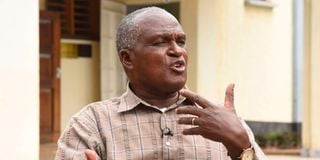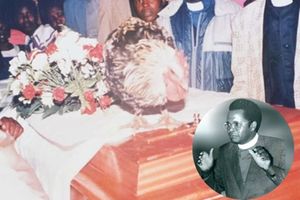
Lay Canon, Davies Omanyo of Anglican Church of Kenya Eldoret Diocese, one of the survivors in a controversial accident at Kipkaren River in Uasin Gishu County where Bishop Alexander Kipsang Muge died.
Davies Omanyo remembers the speeding truck with headlights on like it was yesterday. That was 34 years.
The truck was hurtling down towards the bridge over Kipkaren River on the Webuye-Eldoret road on the evening of August 14, 1990.
It was 3.30pm. Omanyo should have been driving the car going uphill but his boss – Church of the Provice of Kenya (CPK) Eldoret Diocese Bishop Alexander Muge – was the driver. CPK later changed its name to the Anglican Church of Kenya (ACK).
Others in the car were the bishop’s two secretaries, Claire Kerubo and Rhodah Cheboo. The four watched in horror as the truck approached and rammed the car.
“The lorry was fast and headlights were on,” Omanyo said calls last week.
“It had been drizzling. We were hit and pushed off the road, rolling back about 100 metres,” Omanyo recounted.
The bishop was the only fatality. Kerubo later died and Cheboo went to the US.
“Had the lorry rolled one more time, there would be no survivors,” he said.
On regaining consciousness, he unbuckled and checked on the bishop.
The rear of their car was ripped off and the steering wheel hit Muge in the chest. Omanyo crawled out through the bonnet area.
“I thought I could easily pull him out but he dropped his head. I knew he was dead,” he said.

Alexander Kipsang Muge.
He began flagging down other vehicles, including those that were in their convoy that they had overtaken at Kaburengu junction.
Omanyo had been with the bishop from morning. He had left his house early as they were expected at the office around 6am.
“When I reached the office he asked me to give my car to someone else. He said I would drive with him,” he recounted.
On the way, they talked a lot as they were heading to Omanyo’s home district, Busia.
On reaching Bungoma, they noticed two Landrovers following them.
“Such vehicles belonged to Special Branch,” Omanyo said referring to the then-state intelligence service.
Omanyo drove faster
“There were many such vehicles between Bungoma and Malaba. They were monitoring us. We would overtake one and encounter another ahead.”
They then took the Malabo-Busia road. Because he was familiar with the road, Omanyo drove faster.
He took a short cut in Alupe, shaking off the vehicles trailing them.
When the bishop and his group arrived in Busia, they drove to town where they found a huge crowd waiting.
Bishop Muge then walked to St Stephen’s Church, with the crowd following him.
Before leaving for Busia, the bishop apparently made a final call on what turned to be his final day.
“I followed him to his office because he was talking on phone, either to somebody outside the country, in the country or the Archbishop Canterbury,” he said.
“He was saying: ‘I’m going to Busia and if I die, the government is responsible’. We became aware that we would be disrupted on the road.”

The late Bishop Alexander Kipsang Muge, his wife the late Herma Muge and their children Andrew Muge (standing second left), Armon Muge (standing second right), Esther Jebet Muge (seated left) and Elizabeth Muge.
During the service in Busia, Bishop Muge said he was ready to drop a bombshell.
“He said: ‘Politicans are getting too much. I ’m going to name people who killed Ouko’,” he said, referring to the Foreign Affairs minister Robert Ouko was found murdered in February of that year.
Busia-Kisumu road
“I’m going to mention them outside the church,” Omanyo quotes the bishop as saying.
From the border town, they took the Busia-Kisumu road.
Instead of using Kapsabet road, he went through Kakamega where he hosted those in his convoy of about six vehicles to lunch.
“When we left Golf Hotel and having taken over as the driver, Muge stayed behind for about 15 minutes as the convoy hit the road in a bid to shake off suspicious vehicles trailing him,” Omanyo says.
He went to KCB to greet a friend. After that, he started driving as they discussed about the day’s events. They linked up with convoy in Kaburengu but went ahead, driving a little faster until Kipkaren River where the accident occurred.
Omanyo believes it was a planned accident and that those involved must have been communicating with others trailing them to know their location.
While he was lucky to come out alive, Kerubo suffered a cut on the face while Cheboo – who sat behind the bishop – broke a leg.
Bishop Muge stood no chance. He did not utter a word.
Mr Omanyo is a lay canon at ACK St Mathew’s Cathedral where Bishop Muge, who died aged 42, is buried.







